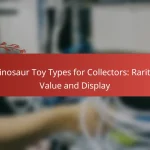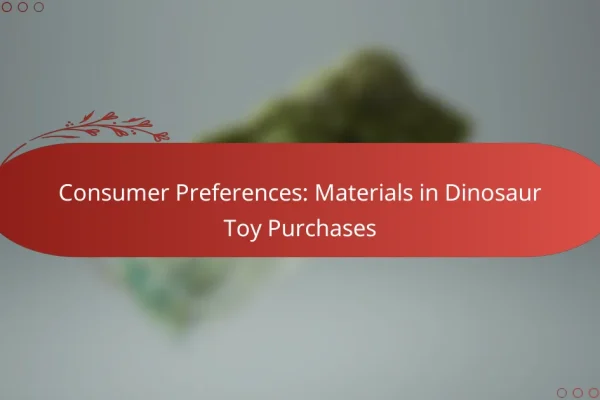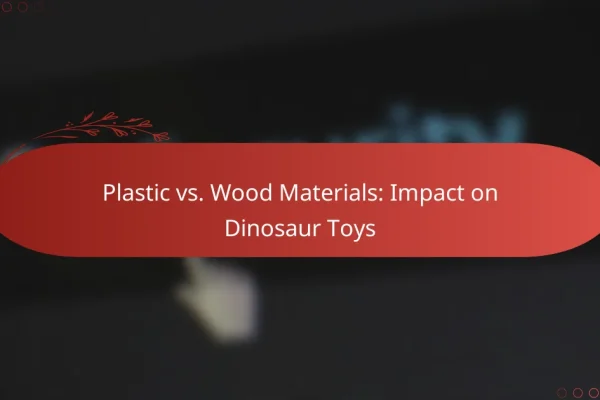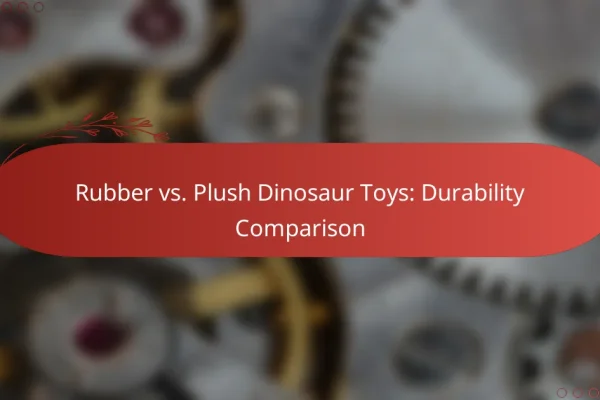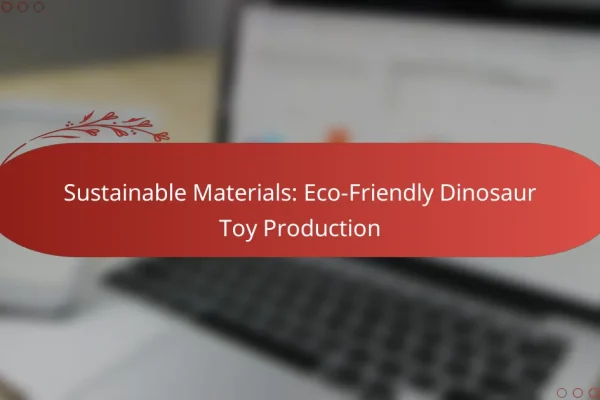What are the best materials for dinosaur toys?
The best materials for dinosaur toys include plastic, wood, rubber, and eco-friendly options. Each material has unique properties that affect durability, safety, and playability.
Plastic durability
Plastic is one of the most common materials for dinosaur toys due to its durability and resistance to wear. High-quality plastic can withstand rough play, making it suitable for children of various ages.
When selecting plastic toys, look for those labeled as BPA-free and phthalate-free to ensure safety. Additionally, consider toys made from ABS or PVC, as these plastics are known for their strength and longevity.
Wooden toy benefits
Wooden dinosaur toys offer a classic appeal and are often more environmentally friendly than their plastic counterparts. They are typically made from sustainably sourced wood, which can be a selling point for eco-conscious parents.
Wooden toys are generally more durable against wear and tear but may not be as resistant to moisture. Look for toys that have a non-toxic finish to ensure safety during play.
Rubber flexibility
Rubber dinosaur toys are known for their flexibility and soft texture, making them safe for younger children. They can withstand bending and squeezing, which adds to their playability.
When choosing rubber toys, ensure they are made from natural rubber or high-quality synthetic rubber that is free from harmful chemicals. This will enhance both safety and durability.
Eco-friendly options
Eco-friendly dinosaur toys are made from sustainable materials such as recycled plastics, organic cotton, or biodegradable substances. These options are increasingly popular among parents who prioritize environmental responsibility.
When selecting eco-friendly toys, check for certifications like FSC (Forest Stewardship Council) for wood or GOTS (Global Organic Textile Standard) for textiles. These certifications help ensure that the materials used are safe and sustainably sourced.
How do materials affect the durability of dinosaur toys?
The materials used in dinosaur toys significantly influence their durability, impacting how well they withstand wear and tear during play. Different materials offer varying levels of resistance to impact, longevity, and susceptibility to damage, which can affect their lifespan and safety for children.
Impact resistance of plastic
Plastic is a common material for dinosaur toys due to its lightweight and impact-resistant properties. High-density polyethylene (HDPE) and polyvinyl chloride (PVC) are often used, providing good durability against drops and rough handling. However, lower-quality plastics may crack or break under stress, so it’s essential to choose toys made from sturdy, high-grade plastic.
When selecting plastic dinosaur toys, look for those that meet safety standards, such as ASTM or EN71, which ensure they can withstand typical play conditions without breaking easily.
Longevity of wooden toys
Wooden dinosaur toys are known for their durability and timeless appeal. They can last for years, often becoming family heirlooms, provided they are made from solid hardwood and finished with non-toxic sealants. The natural grain of wood also adds aesthetic value, making them attractive for both play and display.
However, wooden toys can be susceptible to moisture damage and may splinter if not cared for properly. To maintain their longevity, store wooden toys in a dry environment and clean them with a damp cloth rather than soaking them in water.
Wear and tear of rubber
Rubber dinosaur toys are flexible and often designed for younger children, making them less likely to cause injury during play. They can absorb impacts well but may wear down over time, especially if exposed to sunlight or extreme temperatures, which can lead to cracking or fading.
To prolong the life of rubber toys, avoid leaving them outside for extended periods and clean them regularly with mild soap and water. Check for signs of wear, such as cracks or tears, and replace them if they become damaged to ensure safe play.
Which brands offer the most durable dinosaur toys?
Brands known for durable dinosaur toys include Schleich, LEGO, and Playmobil. These companies emphasize quality materials and construction techniques to ensure their toys withstand rough play and last for years.
Schleich quality standards
Schleich is renowned for its high-quality standards, focusing on realistic designs and robust materials. Their dinosaur toys are made from durable plastic that can endure heavy use, making them suitable for both play and display.
The manufacturing process involves strict quality control measures, ensuring that each toy meets safety regulations and durability expectations. Schleich toys often come with a slight premium price, reflecting their commitment to quality.
LEGO durability features
LEGO dinosaur sets are designed with interlocking bricks that provide structural integrity and resilience. The ABS plastic used in LEGO products is known for its strength and longevity, allowing for creative play without fear of breakage.
Additionally, LEGO pieces are rigorously tested for durability, ensuring they can withstand drops and rough handling. This makes LEGO a preferred choice for children who enjoy building and rebuilding their dinosaur creations.
Playmobil material choices
Playmobil dinosaur toys are crafted from high-quality plastic that is both lightweight and durable. The materials used are designed to be safe for children and can withstand the rigors of active play.
Playmobil emphasizes safety and longevity, with toys that are easy to clean and maintain. Their dinosaur figures often feature movable parts, enhancing playability while maintaining a sturdy construction that resists wear and tear.
What should I consider when choosing dinosaur toys for children?
When selecting dinosaur toys for children, prioritize materials, safety certifications, and design features. These factors ensure that the toys are not only enjoyable but also safe and suitable for the child’s age group.
Age-appropriate materials
Choosing age-appropriate materials is crucial for the safety and enjoyment of dinosaur toys. For younger children, opt for soft, non-toxic materials like rubber or plush, which reduce the risk of injury. For older kids, durable plastics or hard materials can provide more intricate designs and features.
Check for labels indicating the recommended age range. Toys designed for toddlers should be larger and free of small parts, while those for older children can include more complex elements that encourage imaginative play.
Safety certifications
Safety certifications are essential indicators of a toy’s reliability. Look for toys that meet standards set by organizations like ASTM or EN71, which ensure they have been tested for harmful substances and safety hazards. These certifications provide peace of mind for parents regarding the toy’s safety.
Additionally, consider toys that have passed third-party testing. This can further assure you that the dinosaur toys are safe for children to use, minimizing the risk of choking or exposure to toxic materials.
Design and playability
The design and playability of dinosaur toys significantly impact a child’s engagement and creativity. Look for toys that are visually appealing and feature realistic details, which can enhance imaginative play. Toys that can be manipulated, such as those with movable parts, often provide more interactive experiences.
Consider the balance between simplicity and complexity in design. While younger children may prefer straightforward designs, older kids might enjoy toys that offer more intricate play scenarios, such as dinosaur figures that can be combined with playsets or accessories.
How do dinosaur toy materials compare in terms of safety?
Dinosaur toy materials vary significantly in safety, with non-toxic plastics, natural wood, and rubber being the most common options. Each material has specific certifications and standards that ensure they are safe for children, making it essential for parents to understand these differences.
Non-toxic plastic certifications
Non-toxic plastics are often labeled with certifications such as ASTM, CPSIA, or EN71, which indicate compliance with safety standards for toys. These certifications ensure that the materials used do not contain harmful chemicals like phthalates or lead. When selecting dinosaur toys made from plastic, look for these labels to guarantee safety for your child.
Common types of non-toxic plastics include polyethylene and polypropylene, which are generally considered safe for children’s toys. Always check for manufacturer details regarding the specific certifications to ensure compliance with safety regulations.
Natural wood finishes
Dinosaur toys made from natural wood typically use finishes that are free from harmful chemicals, such as water-based paints or natural oils. These finishes help maintain the toy’s safety while providing an appealing aesthetic. When purchasing wooden toys, look for those labeled as “child-safe” or “non-toxic” to ensure they meet safety standards.
Wooden toys can also be more durable than plastic options, making them a long-lasting choice. However, it is crucial to verify that the wood is sourced sustainably and treated with safe finishes to avoid any potential hazards.
Rubber safety standards
Rubber toys, particularly those made from natural rubber, often meet safety standards such as ASTM and EN71, ensuring they are free from harmful substances. Natural rubber is biodegradable and can be a safer alternative to synthetic rubber, which may contain additives that are not child-friendly. Always check for certifications when selecting rubber dinosaur toys.
When considering rubber toys, look for those that are labeled as “BPA-free” and “phthalate-free” to ensure they are safe for children. Additionally, rubber toys can be softer and more flexible, making them less likely to cause injury during play.
What are the emerging trends in dinosaur toy materials?
Emerging trends in dinosaur toy materials focus on sustainability, safety, and durability. Manufacturers are increasingly using eco-friendly materials and non-toxic substances to appeal to environmentally conscious consumers and ensure child safety.
Eco-friendly materials
Eco-friendly materials, such as biodegradable plastics and recycled materials, are gaining popularity in the dinosaur toy market. These materials reduce environmental impact and cater to parents who prioritize sustainability. For instance, some brands now offer toys made from plant-based plastics that decompose more easily than traditional options.
Non-toxic and safe options
Safety is paramount when selecting dinosaur toys, leading to a rise in non-toxic materials. Many manufacturers are now adhering to strict safety standards, such as ASTM and EN71, ensuring their products are free from harmful chemicals. Parents should look for certifications on packaging to confirm that toys meet safety regulations.
Durability and longevity
Durability is a key consideration for dinosaur toys, as children often subject them to rough play. High-quality materials like ABS plastic and silicone are becoming standard due to their resilience. When choosing toys, consider options that offer warranties or guarantees, indicating the manufacturer’s confidence in their product’s longevity.



